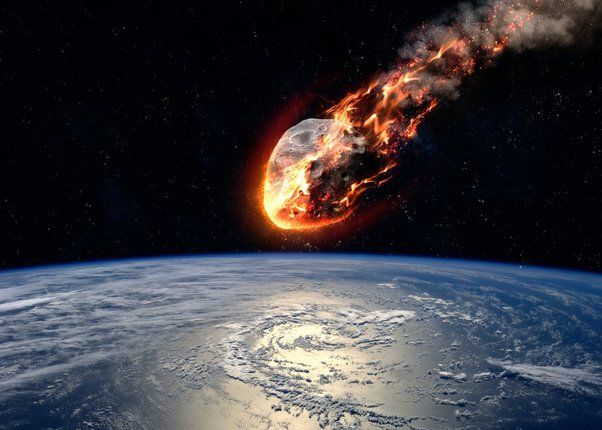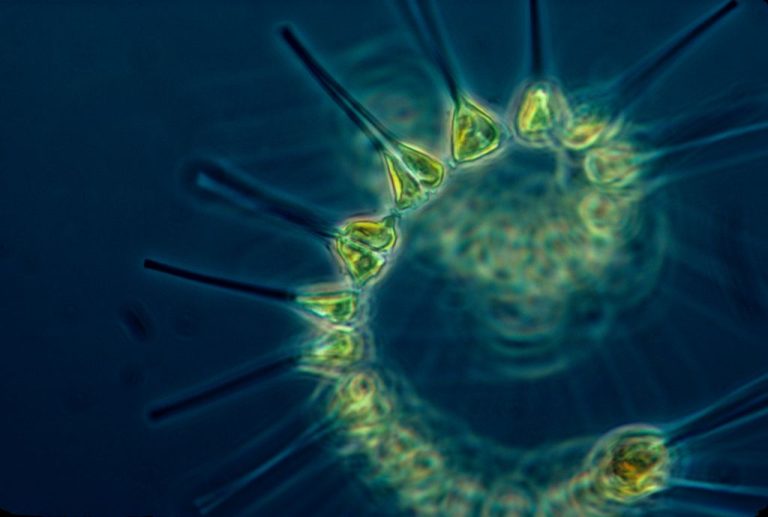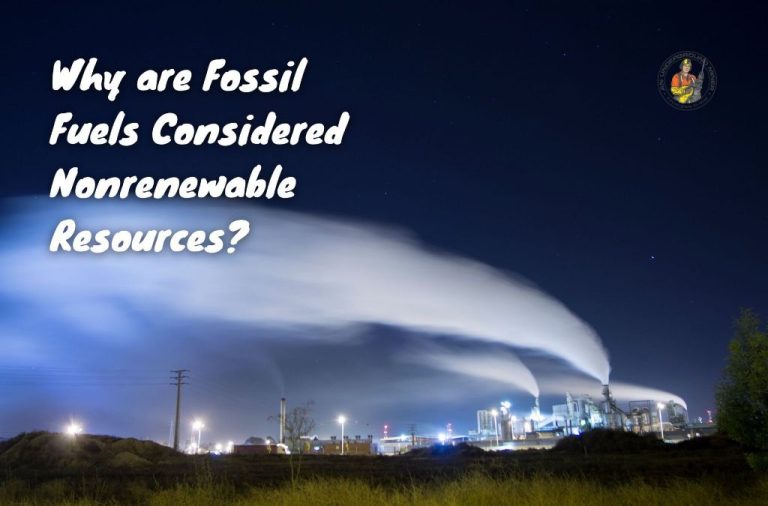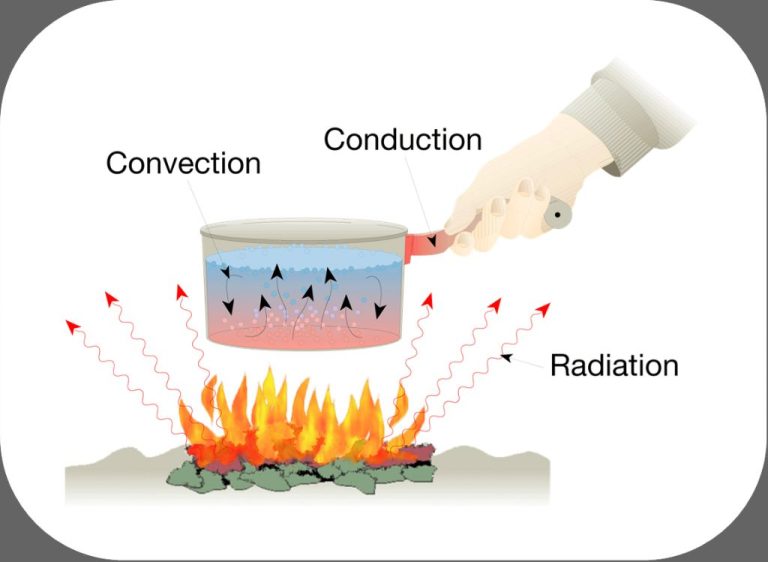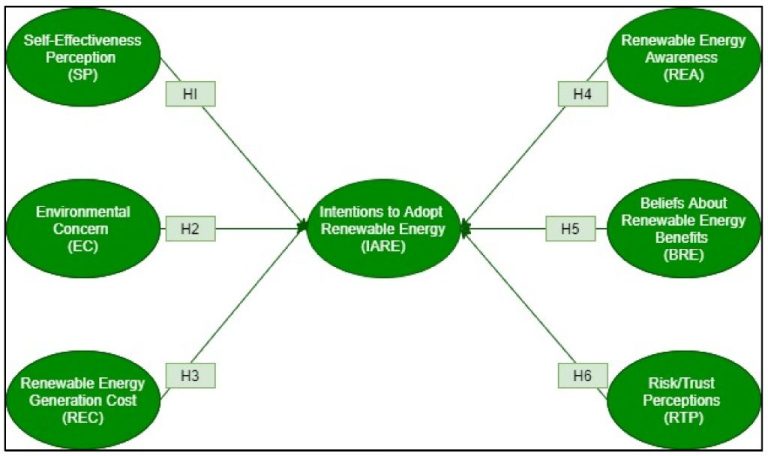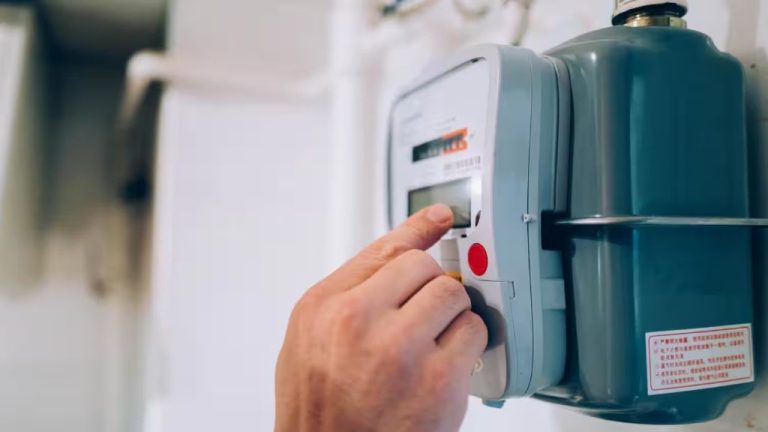What Is The Cycle Between The Oceans Land And Atmosphere?
The water cycle, also known as the hydrologic cycle, describes the continuous movement of water between the oceans, land, and atmosphere. It is a fundamental process that maintains Earth’s water supply and regulates the planet’s climate. Some key parts of the water cycle include:
– Evaporation – The process in which water transitions from a liquid to a vapor or gas, occurring on the surface of oceans, lakes, rivers, and soils.
– Condensation – The process in which water vapor becomes liquid, forming clouds.
– Precipitation – Water falling to the Earth as rain, snow, sleet, or hail.
– Infiltration – Water soaking into the ground and becoming groundwater.
– Surface Runoff – Water flowing overland to rivers, streams, and oceans.
The water cycle has no beginning or end. It is an incredibly important natural process that recycles Earth’s fixed water supply and purifies water through evaporation and precipitation. This introductory overview will discuss the various steps and components that make up the global water cycle.
Evaporation
Evaporation is the process by which water changes from a liquid state to a gaseous state. This occurs when the molecules of water gain enough energy from the ambient heat of the environment to overcome the intermolecular forces holding them together, allowing them to transform to water vapor and rise into the air. Evaporation occurs continuously from water surfaces like oceans, lakes, rivers, moist soil, and plants.
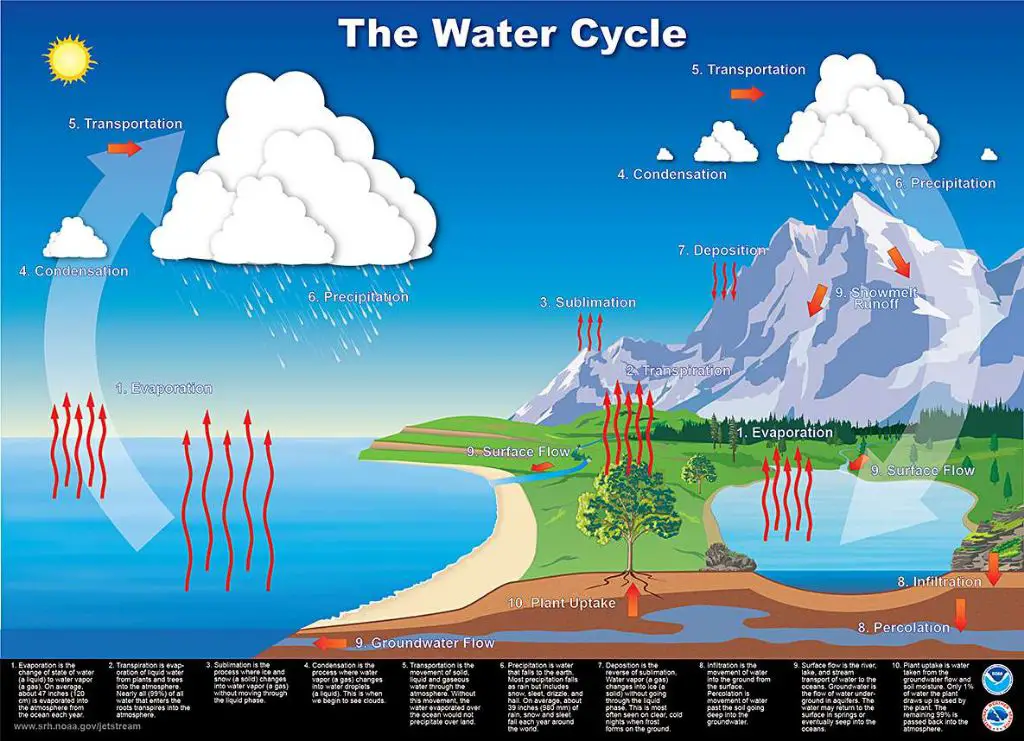
The rate of evaporation depends on factors like temperature, humidity, wind speed, and surface area of the water body. Higher temperatures provide more energy for evaporation, causing it to speed up. Lower humidity means the air can absorb more moisture, also increasing the evaporation rate. Higher wind speeds remove the evaporated water vapor faster, allowing more evaporation to happen. Larger surface areas of water bodies like oceans allow more overall evaporation.
On average, about 90% of water evaporated into the atmosphere comes from oceans, with the remaining 10% coming from other sources like lakes, rivers, and moisture in soil and plants. Oceans lose about 4 feet of water per year to evaporation. Lakes can lose 1-10 feet per year depending on climate conditions. Hot and dry areas see higher evaporation rates than cool and humid areas.
Transportation
Water vapor is transported in the atmosphere via wind in a process known as advection. As water evaporates from the oceans, lakes, rivers, and soil, it enters the atmosphere as water vapor or moisture. The winds then carry this water vapor horizontally across the globe. The winds flow from areas of high pressure to areas of low pressure. So water vapor gets transported by the winds from areas of evaporation to other areas of the planet.
The movement of water vapor around the globe by wind is a key part of the water cycle. Without wind transportation, water vapor would not be able to reach inland areas far from the oceans. The wind allows moisture to spread across continents so that rain and precipitation can occur globally. Advection by wind is a continuous process as evaporation is constantly adding water vapor to the atmosphere.
The speed and direction of winds affect how quickly and where water vapor is transported. Global wind patterns are complex with major wind belts like the trade winds, westerlies, and polar easterlies. The transportation process also moves heat energy around the planet, transferring heat from the equator towards the poles. So advection by wind helps regulate the global climate and enables the water cycle to function across the entire planet.
Condensation
Water vapor in the air condenses to form clouds through a process called condensation. Condensation happens when warm air containing water vapor is cooled to its dew point temperature. The dew point temperature is the temperature at which the air becomes saturated with water vapor and can no longer hold it. As the air cools, it reaches this saturation point and the water vapor condenses onto tiny particles like dust or soot that are suspended in the air. This condensed water vapor forms tiny droplets that group together to create clouds.
Certain conditions are needed for condensation and cloud formation to occur. First, the air must contain sufficient water vapor. This water vapor enters the air through evaporation from the Earth’s surfaces. Second, the air must be cooled to its dew point temperature. Cooling often happens when an air mass rises in the atmosphere and the pressure drops. The drop in pressure reduces the air’s ability to hold moisture. Third, condensation nuclei like dust particles must be present for the water vapor to condense onto. Without these particles, the water vapor would remain in gaseous form as the air cooled. The combination of sufficient water vapor, cooling, and condensation nuclei allows clouds to take shape high in the atmosphere through the process of condensation.
Precipitation
As the moist air rises, it cools and condenses into liquid water or ice particles that form clouds. The water droplets or ice particles in the clouds collide, grow, and fall to the earth as precipitation in the form of rain, snow, sleet, or hail. The type of precipitation that falls depends on the temperature profile through the atmosphere.
Rain falls when the temperature is above freezing throughout the atmosphere. Snow falls when the temperature is below freezing high in the atmosphere where condensation forms ice crystals. As these crystals fall through a layer of air that is above freezing, the crystals may melt and refreeze into sleet. If the temperature near the surface remains below freezing, the precipitation can reach the ground as snow.
Hail forms when strong updrafts carry raindrops into extremely cold areas of the atmosphere, causing them to freeze into balls of ice. These hailstones grow as they are held aloft by winds and collide with supercooled water droplets that freeze onto the core hailstones, causing them to grow in size and mass until they become too heavy to be supported by the updrafts and fall to the ground as hail.
The amount of precipitation that falls at a given location depends on factors like topography, air temperature profiles, and proximity to moisture sources. Areas downwind of large bodies of water tend to receive significant precipitation, while interior continental regions and areas in the lee of mountains are generally drier.
Infiltration
Infiltration refers to the process by which water on the ground surface enters the soil. When precipitation falls, some of the water will infiltrate into the ground while the rest becomes surface runoff. The rate at which infiltration occurs depends on several factors:
- Soil composition – Sandy soils allow faster infiltration than clay soils.
- Vegetative cover – Plants and trees slow infiltration and allow more time for water to soak into the ground.
- Slope of the land – Steeper slopes encourage faster runoff rather than infiltration.
- Antecedent soil moisture – Drier soils allow more rapid infiltration.
Infiltration is crucial to recharging groundwater supplies and providing moisture to plant roots. However, infiltration can also leach pollutants from the surface into groundwater. Understanding infiltration rates helps hydrologists manage water resources and prevent contamination.
Surface Runoff
Surface runoff occurs when precipitation reaches the Earth’s surface and flows downhill under the influence of gravity. The water moves over the land until it eventually reaches a water body such as an ocean, lake, or river. Several factors affect the rate of surface runoff including topography, soil composition, vegetation cover, and precipitation intensity.
Areas with steep slopes facilitate rapid surface runoff because water moves quickly downhill. Impermeable soils like clay also increase runoff potential since they restrict water infiltration into the ground. Sparse vegetation and urbanization reduce interception and absorption of precipitation, leading to more overland flow. High intensity rainfall events overcome the absorptive capacity of soil and vegetation, increasing runoff volumes.
As surface runoff flows down gradients, it collects in lower-elevation surface water bodies. Streams and rivers then transport this water back to oceans and lakes. Runoff is highest near rivers and coastlines because proximal land areas drain into these water bodies. Surface runoff accounts for the majority of freshwater flow from land back into the oceans. This runoff water also carries sediments, nutrients, pollutants, and other substances from the land into the water cycle.
Groundwater Flow
Groundwater flow refers to the movement of water underground through spaces in soil, sand, gravel, fractures in rock, and other geological formations. This water is stored in underground aquifers, which are layers of permeable rock, sediment, or soil that hold or transmit groundwater below the water table. Aquifers are recharged or replenished by precipitation that infiltrates the soil and percolates down into the groundwater system.
Groundwater flows slowly through aquifer layers at speeds ranging from only a few centimeters per day up to a few meters per day, depending on the permeability of the geological material. In some karst aquifers containing many fractures and conduits, groundwater can flow much faster at rates up to several kilometers per day. The direction of groundwater flow is from areas of high hydraulic head to areas of low hydraulic head, following gravity and hydraulic gradients underground similar to how surface water flows above ground. Groundwater discharge replenishes streams, lakes, wetlands, and oceans to complete the hydrologic cycle. Proper management of aquifers and sustainable groundwater pumping is important to maintain adequate water supplies.
Plant Transpiration
Transpiration is an important part of the water cycle that involves the movement of water within plants and the evaporation of water from the leaves of plants and trees into the atmosphere. During transpiration, plants absorb water from the soil through their roots. This water is then transported up the stem and to the leaves through specialized plant cells known as xylem.
Once the water reaches the leaves, some of it evaporates through tiny pores on the underside of leaves called stomata. The stomata open and close to regulate this evaporation process, known as transpiration. When the stomata are open, water vapor evaporates from the moist cell walls of the mesophyll cells inside the leaf, creating a pull that draws more water up from the roots.
The transpiration process creates a continuous stream of moisture leaving the plant’s leaves and entering the atmosphere. This moisture then condenses to form clouds, which can eventually lead to precipitation, continuing the cycle. Transpiration serves important functions for the plant such as cooling the leaf temperature, enabling the flow of minerals from roots to shoots, and providing the pull that draws water up from the roots.
On a global scale, the process of transpiration from countless plants and trees all over the world contributes massive amounts of water vapor to the atmosphere. Estimates suggest that 10% of the moisture in the atmosphere comes from transpiration, making it an essential part of Earth’s water cycle.
Conclusion
The water cycle is the continuous movement of water between the ocean, atmosphere, and land. It is a closed loop system where water is constantly being recycled. The main processes in the water cycle are:
– Evaporation: This occurs when the sun heats up water on the earth’s surface, turning it into water vapor that rises into the air. Most evaporation occurs over the oceans.
– Transportation: The water vapor is transported around the globe by winds in the atmosphere.
– Condensation: As the water vapor cools, it condenses onto tiny droplets that form clouds.
– Precipitation: The water droplets in clouds grow larger until they fall back to the earth as precipitation like rain, snow, sleet or hail.
– Infiltration: Some precipitation soaks into the ground to become part of the soil moisture and groundwater storage.
– Surface Runoff: Precipitation that flows over the land surface is called runoff and drains into lakes, rivers, and oceans.
– Groundwater Flow: Groundwater that is stored underground may slowly seep back into rivers, lakes or oceans.
– Plant Transpiration: Plants take up water from the soil and release it back into the air as water vapor through their leaves.
The continuous cycling of water between these various stores on land, ocean, and air is vital for regulating global climates, purifying water, replenishing groundwater, and providing freshwater to living things. The water cycle underscores how important it is to keep our water sources clean and protect the natural environment.

